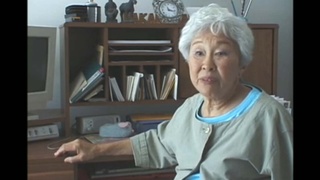Interviews
Collection of artifacts depicting racial stereotypes influences art
And then I have World War II postcards that depict the World War II Jap with the buck teeth and slanted eyes, yellow-skinned and their endless depiction of -- and I almost have all of 'em now. I must have about thirty or forty of 'em. And other ones that are just really foul, dogs urinating on Jap heads and things, defecating on them, and they're all these different versions. I have magazine advertisements of those same kinds of depictions, Jap hunting licenses that companies gave away, you put stamps on 'em and how many Japs you've killed. I have Slap a Jap cards that were clubs that you would join and every time you were supposed to slap the Jap that you saw. Patriotics, which were envelopes that you use with images on there that were the stereotypes of, of Japanese people, so just about anything that had to do with depictions, negative depictions of Japanese people.
And, of course, all of these things end up informing my paintings, so I've been working on a series called Stereotypes & Admonitions where I depict myself, sometimes as a samurai from a ukiyo-e woodblock print, because that refers to how people see me as the person from Japan, or as that World War II yellow peril threat, which is still that kind of eternal foreigner, but more of a threat. And so what I'll do is I'll put myself under one of those two disguises within a Western framework, so it also refers to that idea of, when you tell a white person that not a day goes by where you don't realize that you're not white, they don't understand what you mean. And that's what this refers to because it's so dramatized with these horrible depictions.
Date: March 18 & 20, 2003
Location: Washington, US
Interviewer: Alice Ito and Mayumi Tsutakawa
Contributed by: Denshō: The Japanese American Legacy Project.
Explore More Videos

Not bringing shame to family
(1926 - 2012) Scholar and professor of anthropology. Leader in the establishment of ethnic studies as an academic discipline

Past ties to present situation in Middle East
(1926 - 2012) Scholar and professor of anthropology. Leader in the establishment of ethnic studies as an academic discipline

Helping soldiers
An expert researcher and scholar on Japanese immigrant clothing.

Okinawan discrimination
An expert researcher and scholar on Japanese immigrant clothing.

Didn't have rights that whites had
(1922–2014) Political and civil rights activist.

Californians didn't know about evacuation
(1922–2014) Political and civil rights activist.

The day Pearl Harbor was bombed
(1922–2014) Political and civil rights activist.

Father as prisoner of war in hospital
(1922–2014) Political and civil rights activist.

Patriotism versus loyalty
(1922–2014) Political and civil rights activist.

Idealism before war, being red, white and blue
(1922–2014) Political and civil rights activist.

Camp as a positive thing
(1922–2014) Political and civil rights activist.

Rounding up Issei and Nikkei
(1922–2014) Political and civil rights activist.

Her experience as a Japanese-American schoolchild in Oceanside, California, after the bombing of Pearl Harbor
(1924-2018) Artist and playwright.

His parents' experience with Japanese resistance toward intermarriage with Okinawans
(b.1925) Nisei of Okinawan descent. Had a 38-year career in Japan as a baseball player, coach, scout, and manager.

Treatment of Kibei after return to United States
(b.1913) Kibei from California who served in the MIS with Merrill’s Marauders during WWII.
